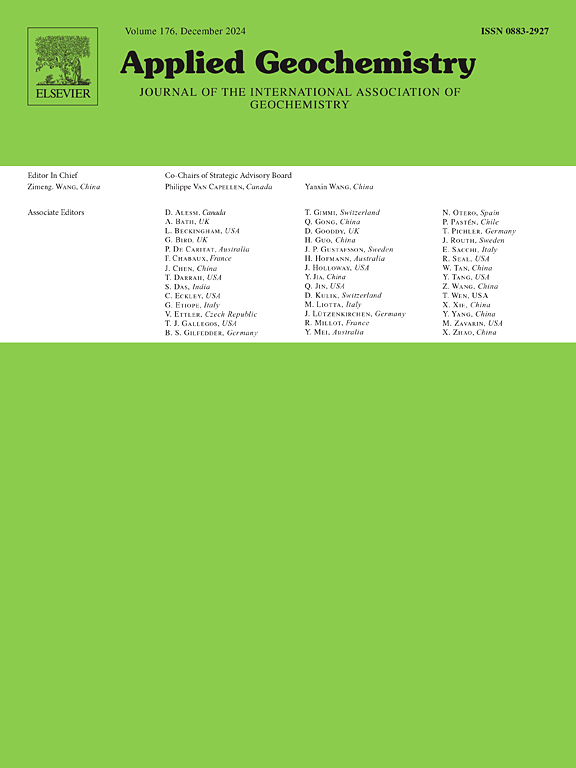加拿大东部马铃薯生产中矿物和有机胶结剂对土壤团聚的贡献
IF 3.1
3区 地球科学
Q1 GEOCHEMISTRY & GEOPHYSICS
引用次数: 0
摘要
土壤团聚是决定土壤健康和质量的关键因素,它是由土壤有机碳、生物群、离子桥、粘土和碳酸盐等各种胶结剂将土壤颗粒粘结在一起的结果。由于农业耕作方式和风化扰动,这一过程在不同的土壤剖面上各不相同。在这项研究中,我们分析了在加拿大东部马铃薯生产的三个土壤层(Ap1、Ap2 和 B)中,不同的胶结剂对土壤团聚的贡献。我们从魁北克省的 29 个地点采集了土壤样本,进行了骨料大小分布分析和固结剂测定。我们的研究结果表明,不同地层中的骨料比例存在差异,与 Ap1 和 Ap2 地层(分别为 20.28% 和 18.71%)相比,B 地层中 2-4.75 毫米骨料的比例较小(10.42%)。根据固结剂对土壤团聚的影响程度,多价金属的影响最大,其次是有机质(C&N)以及淤泥和粘土。然而,根据这些选定的胶结剂通过回归分析来准确估算集聚稳定性仍然具有挑战性。本文章由计算机程序翻译,如有差异,请以英文原文为准。
Contributions of mineral and organic cement agents to soil aggregation under potato production in Eastern Canada
Soil aggregation, a critical determinant of soil health and quality, results from the bonding of soil particles by various cementing agents, such as soil organic carbon, biota, ionic bridging, clay, and carbonates. This process varies across soil profiles due to agricultural practices and weathering disturbances. In this study, we analyzed the contribution of different cementing agents to soil aggregation within three soil horizons (Ap1, Ap2, and B) in potato production in Eastern Canada. We collected soil samples from 29 sites in Quebec Province for aggregate-size distribution analysis and cementing agent determination. Our findings reveal variations in aggregate proportions among the horizons, with horizon B exhibiting a smaller proportion of 2–4.75 mm aggregates (10.42%) compared to horizons Ap1 and Ap2 (20.28% and 18.71%, respectively). The hierarchy of cementing agents' impact on soil aggregation ranks polyvalent metals as the most influential, followed by organic matter (C&N) and silts and clays. However, accurately estimating aggregate stability through regression analysis based on these selected cementing agents remains challenging.
求助全文
通过发布文献求助,成功后即可免费获取论文全文。
去求助
来源期刊

Applied Geochemistry
地学-地球化学与地球物理
CiteScore
6.10
自引率
8.80%
发文量
272
审稿时长
65 days
期刊介绍:
Applied Geochemistry is an international journal devoted to publication of original research papers, rapid research communications and selected review papers in geochemistry and urban geochemistry which have some practical application to an aspect of human endeavour, such as the preservation of the environment, health, waste disposal and the search for resources. Papers on applications of inorganic, organic and isotope geochemistry and geochemical processes are therefore welcome provided they meet the main criterion. Spatial and temporal monitoring case studies are only of interest to our international readership if they present new ideas of broad application.
Topics covered include: (1) Environmental geochemistry (including natural and anthropogenic aspects, and protection and remediation strategies); (2) Hydrogeochemistry (surface and groundwater); (3) Medical (urban) geochemistry; (4) The search for energy resources (in particular unconventional oil and gas or emerging metal resources); (5) Energy exploitation (in particular geothermal energy and CCS); (6) Upgrading of energy and mineral resources where there is a direct geochemical application; and (7) Waste disposal, including nuclear waste disposal.
 求助内容:
求助内容: 应助结果提醒方式:
应助结果提醒方式:


